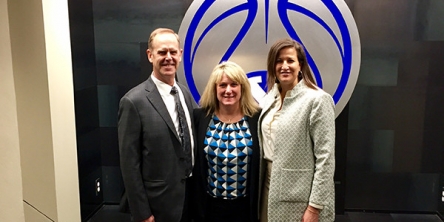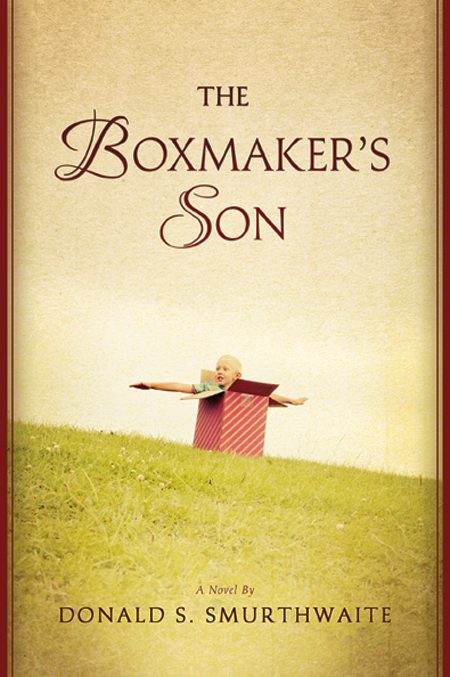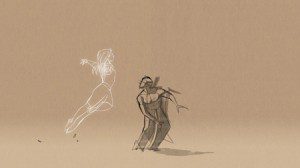In the last four years, Ira Fulton has surprised a lot of people at BYU with big gifts, totaling some $50 million. In response, BYU has re-named the College of Engineering and Technology in Fulton's honor.
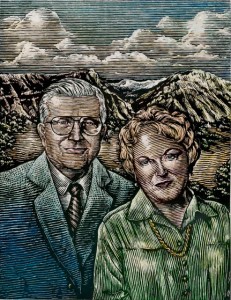
Ira and Mary Lou Foulton | Illustrated by Ken Perkins/ Hedge Graphics
Ira Fulton likes surprises. And not little ones. The Arizona businessman thinks big—in the millions, to be exact.
In late 1999 BYU’s Lighting the Way fund-raising campaign was wrapping up early after surpassing its $250 million goal by some $100 million. The campaign would end officially in December, but fund-raisers planned a September celebration to give a final push toward a new $380 million goal.
President Gordon B. Hinckley, of The Church of Jesus Christ of Latter-day Saints, had other ideas. Speaking at the festivities, he challenged donors and fund-raisers to do just a little more—$20 million more, thus setting a new campaign goal of $400 million by December.
After the meeting Fulton approached President Hinckley and surprised him with Fulton’s first major gift to BYU: a pledge for $20 million.
In the succeeding four years, Douglas M. Chabries, dean of BYU’s engineering college, has become accustomed to such surprises. He regularly watches Fulton stun faculty members he has just met by pointedly asking what kind of resources they need to take their research to the next level.
“They often provide a conservative estimate,” says Chabries. “To which Ira says, ‘Now, don’t poor-boy me. Tell me what you really need. We have to do this first class.’ The faculty member then stammers an estimate, shocked that someone could be that interested in his or her small portion of this large campus.”
Because of Fulton’s delight at seeing people’s faces during such encounters, he has repeated them often, supplying close to $50 million for programs campuswide. His generosity has blessed BYU with one of the fastest supercomputers in American higher education (see “The Magnificent Mary Lou,” p. 41); funded new and improved research, teaching, and athletic facilities; and provided many student scholarships and mentoring opportunities. Name a college or school at BYU, and Fulton has most likely helped it in one way or another (see “Sharing the Wealth,” p. 38). In gratitude, on Nov. 6 BYU renamed Chabries’ corner of campus the Ira A. Fulton College of Engineering and Technology.
The no-nonsense businessman has set a high standard of selflessness, says Chabries. “Ira has been ranked by a national magazine as being among the top 50 philanthropists in the United States,” he says. “I believe that his contributions to the university parallel those of Jesse Knight and Abraham O. Smoot for their time periods.”
David K. Anthony, associate dean of the college, says Fulton’s motivations for giving are pure and come from the heart of a man who has fallen in love with the students and mission of BYU.

Ira Fulton was tutored for success in his early years. Photo courtesy Ira and Mary Lou Fulton.
“Ira wants to support us in achieving our dreams,” says Anthony. “When he became involved with BYU, he quickly saw the excitement in the lives of students as they were able to do things they had only dreamed about. His financial support of the university is evident, but what may not be are the fond bonds of friendship that have developed between Ira and the administration, faculty, and student body. The enthusiasm he provides eclipses his financial impact and fosters an excitement I’ve not seen previously at all levels.”
Why does the philanthropist, who attended Arizona State University before beginning a storied career in sales, technology, clothing, and home building, give so much to an institution of higher education more than 600 miles from his home?
“I’m impressed with the students at BYU—their reverence, their respect,” says Fulton, who is close to finishing construction on a Provo home to be nearer to BYU. “They are no nonsense. They are here to learn, to get their education and move on. They know what their goals are. And when I can participate with these great students and their great professors and help them achieve their goals, that personally excites me.”
Foundations of Success
Born to David and Myrtie Fulton, a hardworking Latter-day Saint couple in Tempe, Ariz., in 1931, Fulton was the last child in a large family. His father, who was 56 at the time of Fulton’s birth, was a miner and worked as a shipbuilder in World War II. His mother ran a hamburger stand and later a café to make ends meet.
“I didn’t know I was poor until I was about 30,” says Fulton, who was often called upon to wash dishes in the café. “I always had food. I always had clothing. I didn’t know growing up that I was really under the poverty line. I wore hand-me-downs until my brothers and sisters left the house when I was 12, but it was just part of being a member of a big family.”
In this environment he learned the value of hard work and of his own abilities.
“When I was 12, my father stood me in front of a mirror and told me, ‘There’s your competition. Don’t compare yourself with others; just compare yourself with you,'” says Fulton, who lives by this and other rules he says have brought him success and happiness.
“My parents always said to me, ‘Do anything the best you can.’ If you mow the yard, mow it the best. If you rake the yard, rake it the best. If you are going to drive a truck, drive it better than anybody else,” says Fulton.
Add to this list delivering dairy products, collecting and selling wild honey, building and loading wooden fruit boxes, and running the Arizona Republic’s largest paper route, and you have an idea of what Fulton’s boyhood years were like.
Fast forward to the late 1950s, where, as an adult, Fulton took his parents’ advice to heart and began to excel in the business world. With a new family to support, Fulton worked as hard as ever, first for National Cash Register, where he became the company’s salesman of the year, and next for Dana Brothers Signal Oil and Gas, where he rose to the level of regional operations manager. Dissatisfied with working for others, he soon left to start two consulting companies, the National Retailer’s Corporation and Computer Audit, which sought government funding and growth financing for retail operations.
In 1976 Fulton became the owner of Eagleson’s Big & Tall men’s clothiers in southern California and Arizona, which he took from a struggling two-store operation to a 33-store chain with sales in the millions. He sold the company in 1995 in a multimillion dollar deal.

Ira Fulton has been sustained through many adventures by his marriage to Mary Lou. He has built and managed various successful businesses, allowing him to now give generously to worthy causes. Photo courtesy Ira and Mary Lou Fulton.
Today he is president and CEO of Fulton Homes, one of the largest builders in Arizona. The company has grown from constructing several homes in 1975 to nearly 1,500 homes in 2002.
“I’ve always enjoyed working and seeing the fruits of my work,” says Fulton. “That’s what I do for fun. That’s my recreation. I own golf courses, but I don’t like to spend my time chasing a little white ball around. I call that burning daylight.”
He didn’t always have a no-play policy. As a boy with patches on the knees of his pants, he enjoyed marbles, the tuba, and Scouting. He was also fond of adventure and mischief.
On one occasion, he and his 16-year-old friends explored a supposedly haunted house adjacent to a graveyard. When the owner learned they were inside, he appeared in the doorway with a shotgun. He told them to get out or he would start shooting.
“I walked out from where my friends and I were hiding and said, ‘You can’t shoot me. I’m Ira Fulton.’ He must have liked my spirit because he barely smiled and said, ‘Alright, you guys—and Ira Fulton—get the heck out of here!'”
This kind of verve manifested itself in other aspects of his life, including his performance on the gridiron, where Fulton excelled in high school as a guard and tackle on offense and a tackle and linebacker on defense. In his senior year, he was selected for the all-state team.
Ira decided to play for the Sun Devils at Arizona State University, where he would meet the most important person in his life, his wife Mary Lou.
Part of the Family
Completely devoted to one another—they will celebrate 50 years of marriage in June—the Fultons are a combination of Ira’s broad smile and enthusiasm and Mary Lou’s bright eyes and spirit.
“When we first met, I could barely believe Ira’s smile. His teeth are perfectly straight, and I wondered for a while if they were real,” says Mary Lou. “I knew he played football, so it was possible he’d knocked some of them out.”
To determine if his choppers were really dentures, she asked one of Ira’s friends to offer him a licorice twist and pull hard when he took a bite. Ira’s teeth stayed in, and Mary Lou was pleased to hear they were indeed his own.
After a whirlwind courtship, which included a broken engagement over a misunderstanding and a reconciliation brought about by Ira’s salesmanship skills, the two married and moved to Phoenix, where, in typical fashion, he had secretly purchased a home for his bride.
“She’s my sweetheart,” says Ira, who likes the fact that all five BYU supercomputers bear Mary Lou’s name. “She’s somebody that I can talk to very easily, somebody that I value as a wife, a friend, a listener, and a companion. Getting Mary Lou on board and having her beside me is the greatest thing that ever happened to me, because from there, everything was straight up. If I didn’t have the gospel, didn’t have my wife, and didn’t have my family, it wouldn’t mean anything. It really wouldn’t.”
Shortly after they were married, Mary Lou, who grew up Baptist, joined the Church, and the couple began a family, which now includes three children: Lorie, Greg, and Doug.

Mary Lou and Ira Fulton are longtime residents of the Phoenix, Arizona, area, where Fulton homes stakes a claim as one of the state’s largest builders. Photo by Mark A. Philbrick, ’75.
From the beginning, Mary Lou appreciated Ira’s charitable heart, something he inherited from his mother, who was quick to provide a meal in her café for someone down on his luck.
“Since the day we’ve been married he’s been giving and giving. He doesn’t hide his attributes,” says Mary Lou. “They’re there and they’re wonderful. And I love him for that—he’s such a giver.”
Along with David Anthony, Art McKinlay shares the distinction of being instrumental in introducing the Fultons to the BYU community.
“Finding Ira and becoming acquainted with him is a once-in-a-lifetime opportunity. This is a warm, enthusiastic person whose relationships with people are meaningful,” says McKinlay, director of corporate giving for LDS Foundation. “When you deal with Ira, you become part of his family.”
Students, such as Paul T. Nelson, ’03, who is earning a graduate degree in mechanical engineering, are grateful for the opportunities and resources available to them because of the Fultons’ generosity. The Interactive Reality Auditorium (IRA), a virtual reality room funded by the Fultons and powered by one of the five supercomputers donated by the Fultons, allows Nelson to display computer-aided designs in 3-D to corporate executives.
“A lot of the scholastic work I do would be impossible without the equipment and facilities provided by Ira Fulton,” says Nelson, a Houston native. “I use the IRA room for visualization research all the time.”
It is this kind of effect that keeps the Fultons coming back to campus for visits with the professors and students they have adopted as family.
“Mary Lou and I see the value of education,” says Ira. “Knowing that I am involved with BYU and am helping boys and girls enrich their education—that’s what it’s all about. I feel that when we convert a new person to our Church, we have no idea what impact that will have five generations from now. Education is the same way. To me, these boys and girls are our future bishops, stake presidents, Relief Society presidents—our future leaders.”
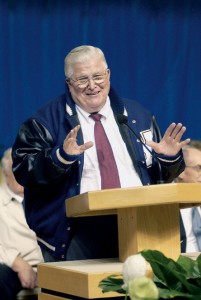
Since 1999 Ira Fulton has become one of BYU’s most ardent supporters, contributing millions from his own funds and actively encouraging others to follow suit. Photo by Mark A. Philbrick, ’75.
Mary Lou agrees. “BYU is such a wonderful place for people who want to follow the plan, to do the right thing,” she says. “I know all these students love to have a good time. They aren’t so different from other people their age, but they are morally clean and their countenances are so beautiful. I see the smiles, and I see the inner glow.”
Accountability and Impact
Ira Fulton’s generosity, however, isn’t completely free; there are strings attached. As he gives, Fulton asks for accountability. “Not because I need it, but because the people I’m giving to need it,” says Fulton, who doesn’t hesitate to get on the phone with someone at BYU to find out how a project is progressing or to share his opinion on an idea. “They need to understand that there’s no such thing as a free handout. I don’t believe in free lunches. But you teach people how to buy their own lunches, how to provide for themselves. You do that and you build character, self-esteem, and pride.”
This vision for the impact of his gifts motivates Fulton, says Dean Chabries. “President Hinckley has challenged us to be a little better and to stand a little taller,” he says. “Ira wants us to be a little better a little faster, and he wants us to stand taller right now.”
“I want the best return from my investment per student,” says Fulton. “That’s all I require. I don’t tell the professors what programs to develop. They present a program to me; I like it. All I want to do is make sure they are doing their homework and producing quality in that student or that program.”
In addition to his contributions, Fulton serves as a member of the executive committee of BYU’s President’s Leadership Council (PLC), a group of top-level donors who encourage and facilitate giving to BYU.
“I feel in some ways like I’m on a mission,” says Fulton, who refers to himself as a professional arm-twister. “I think there are a lot of people out there who can do a better job as a bishop or a mission president than I could. But I think I am good at what I do. The PLC raises millions to build buildings and fund programs like student mentoring, scholarships, and sabbaticals. I’m after the people who have significant assets and who don’t know what to do with them, who are hoarding them, thinking that they can take them with them or give them to their kids to fiddle away. I’m trying to get it back to the Church.”
Part of his strategy in getting others to give big is doing so himself. Fulton’s initial promise to President Hinckley of $20 million has turned into $50 million, and he says more will come.
“So many people today just don’t want to let go of their assets,” says Fulton. “People ask me why I don’t want to be a billionaire. Becoming a billionaire means zilch to me because you can’t take it with you. Now, to give away a billion dollars—that’s important. I just feel blessed that my wife has never, ever told me that I couldn’t give away money—never. But I do like to surprise her with the big numbers.”
Grant Madsen is a media relations manager for BYU‘s University Communications.Feedback: Send comments on this article to magazine@byu.edu.
Sharing the Wealth
By Grant R. Madsen, ’98
The Fultons’ contributions to BYU enrich nearly every corner of campus. Their gifts to the university include the following:
Athletics
Funding for the new athletic complex (byu.edu/about/construction/athletic) and student scholarships support BYU’s men and women athletes.
Biology and Agriculture
Financial backing for biology research allows undergraduates to examine genes that regulate cartilage production and that may someday contribute to osteoarthritis treatments.
Funding for research into long-term food preservation and storage helps researchers determine the shelf life of dehydrated food, catalog methods of storage in different cultures, and develop software that simplifies food-storage recommendations.
Engineering and Technology
A supercomputer facility housing five supercomputers all named in honor of Mary Lou Fulton puts the most technically intensive projects within the reach of student and professor researchers from any college on campus.
Powered by one of the supercomputers, the Interactive Reality Auditorium, a virtual-reality theater, displays 3-D visualizations of automotive designs and engineering by linking to the supercomputer. The theater is also used by animation students from the College of Fine Arts and Communications.
Workstations for the BYU Center for Remote Sensing (an interdisciplinary research organization that spans departments from engineering to geography) enable faculty and student research on icebergs, hurricanes, flooding, and other natural phenomena. Resulting data and analyses have been provided to NASA and other government organizations (cers.byu.edu).
Financial support has streamlined the School of Technology’s Construction Management and Information Technology Programs and helped prepare their students for today’s technology-driven world (et.byu.edu/sot).
Family, Home, and Social Sciences
Renovations of and funding for the 12th-floor neuroscience lab in the Spencer W. Kimball Tower deepen and improve psychology student research.
Fine Arts and Communications
Cutting-edge production and editing equipment improves training for theatre and media arts students interested in becoming cinematographers, audio technicians, or multimedia creators.
Harold B. Lee Library
Two high-speed scanners allow staff to convert documents to digital images up to four times faster than with previous equipment (www.lib.byu.edu/online.html).
Humanities
Funds for the new Joseph F. Smith Building will help house much of the College of Humanities, as well as units from the College of Family, Home, and Social Sciences (byu.edu/about/construction).
Museum of Art
A state-of-the-art inventory system improves collection management and allows people from around the world to experience the collection via the Internet (lib.byu.edu/hbll/ moa). A donated Francis David Millet painting, Thesmophoria, supplements the museum’s collection with an example of the beaux-arts tradition.
Physical and Mathematical Sciences
Software helps chemistry and biochemistry students and faculty virtually construct, edit, and visualize molecules in 3-D—all essential for modern drug design and development.
Public Affairs and Guest Relations
Dozens of electric golf cart–type vehicles, known as GEM cars, efficiently move people and equipment at BYU.
BYU–Hawaii
A scholarship fund brings students from Mongolia and Cambodia to study at BYU–Hawaii.







